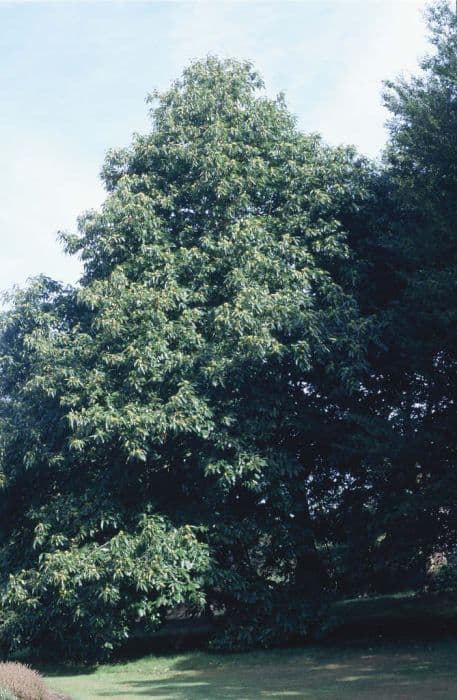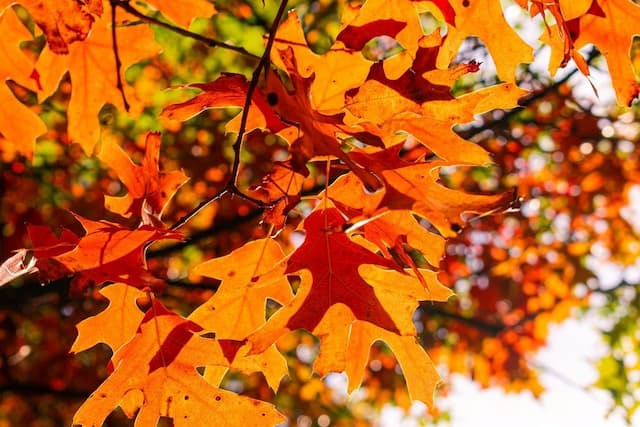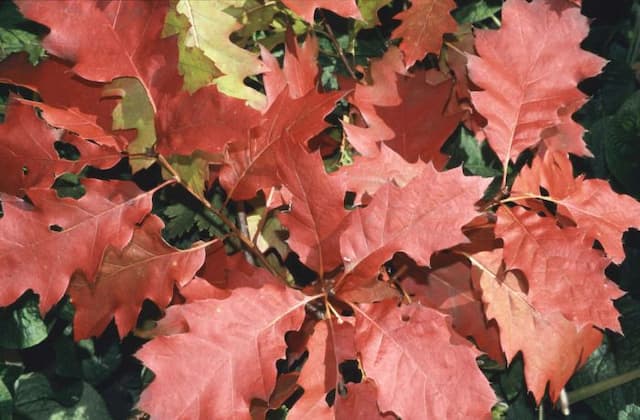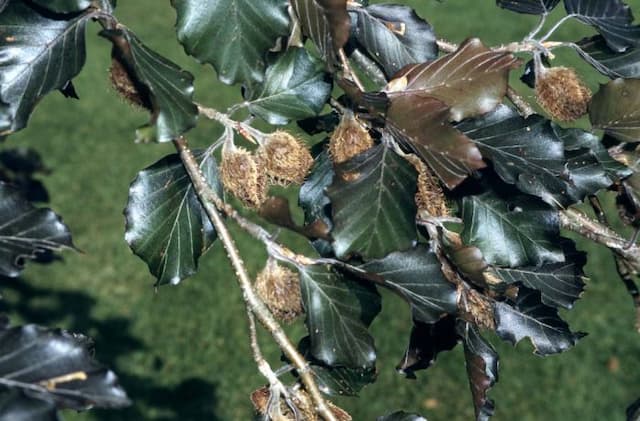Holm oak Quercus ilex
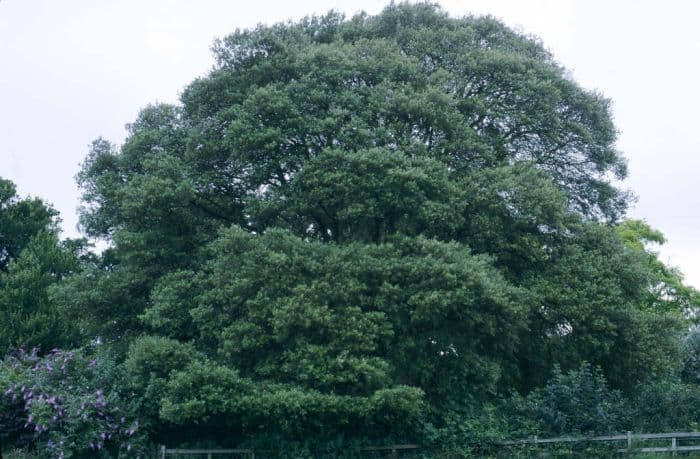
ABOUT
Quercus ilex, commonly known as the Holm oak or Holly oak, is an evergreen tree with a robust appearance. Its foliage consists of dense, dark green leaves that are glossy on the upper side and paler beneath with a felted texture. The leaves are distinctively shaped, somewhat resembling the leaves of a holly - generally oval with a spiny-edged margin which becomes smoother with age. The Holm oak has a rounded crown supported by a thick trunk. The bark is blackish grey and develops deep, furrowed ridges over time, giving it a rugged texture. When the tree is in bloom, it produces male flowers in the form of slender, pendulous yellow catkins and small, inconspicuous female flowers that later mature into acorns. The acorns of the Holm oak are held in a tough, leathery cup and take on a shiny appearance, ranging from a green to a more mature brownish hue.
About this plant
 Names
NamesFamily
Fagaceae.
Synonyms
Holm Oak, Holly Oak, Evergreen Oak.
Common names
Quercus ilex L., Quercus ballota, Quercus ilex var. ballota, Quercus rotundifolia, Quercus rotundifolia Lam.
 Toxicity
ToxicityTo humans
Quercus ilex, commonly known as Holm Oak, is not typically considered highly toxic to humans. However, like many oaks, the acorns and leaves contain tannins which can be harmful if consumed in large quantities. Eating significant amounts of acorns or leaves may lead to gastrointestinal distress, with symptoms such as stomach pain, nausea, vomiting, and diarrhea. In very rare cases, excessive consumption may lead to more severe symptoms due to tannin poisoning.
To pets
The Holm Oak is also known to pose similar risks to pets as to humans. Its acorns and leaves contain tannins which can cause gastrointestinal discomfort in animals if ingested in large amounts. Symptoms in pets may include vomiting, diarrhea, abdominal pain, and lack of appetite. Continued or severe consumption may lead to more serious health issues such as kidney or liver damage. Pet owners should discourage their pets from eating acorns or leaves from the Holm Oak to prevent any potential toxicity.
 Characteristics
CharacteristicsLife cycle
Perennials
Foliage type
Evergreen
Color of leaves
Green
Flower color
Yellow-green
Height
65 feet [20 meters]
Spread
65 feet [20 meters]
Plant type
Tree
Hardiness zones
7
Native area
Mediterranean
Benefits
 General Benefits
General Benefits- Shade provision: Quercus ilex, commonly known as the Holm oak, has a dense canopy that offers ample shade, creating a cooler microclimate beneficial in hot areas.
- Erosion control: The root system of the Holm oak helps stabilize soil, reducing erosion on slopes and hillsides.
- Longevity: As a long-lived species, the Holm oak provides a stable habitat and structure for many years.
- Wildlife support: It offers food in the form of acorns and habitat for a variety of birds, mammals, and insects.
- Landscape aesthetics: With its evergreen foliage, the Holm oak is valued for its beauty and can enhance garden designs and natural landscapes.
- Durability: The wood of Holm oak is hard and tough, suitable for construction and making durable goods such as furniture and tools.
- Drought resistance: Adapted to Mediterranean climates, it is highly resistant to drought, requiring minimal water once established.
- Cultural significance: The Holm oak is an iconic tree in many Mediterranean cultures, with historical and symbolic importance.
 Medical Properties
Medical Properties- Antiseptic: Quercus ilex, commonly known as Holm oak, has been used for its antiseptic properties, particularly in Mediterranean folk medicine.
- Astringent: The tannins present in Holm oak bark are believed to have astringent qualities, which can be utilized in the treatment of minor cuts and abrasions.
- Anti-inflammatory: Some traditional uses of Holm oak involve reducing inflammation, although rigorous scientific evidence to support these uses might be lacking.
- Antidiarrheal: Due to its astringent effects, the bark of Quercus ilex may have been used in treating diarrhea in some traditional practices.
 Air-purifying Qualities
Air-purifying QualitiesThis plant is not specifically known for air purifying qualities.
 Other Uses
Other Uses- The wood of Holm oak is highly valued for its density and hardness, making it suitable for construction and flooring.
- Due to its durability and resistance to decay, Holm oak wood is also used for making wine barrels, which can impart a distinct flavor to the wine.
- The tannins extracted from the bark of Holm oak are used in the leather tanning industry to produce high-quality leather goods.
- Charcoal produced from Holm oak wood is considered superior for grilling due to its ability to burn hot and steady, providing excellent heat for cooking.
- The acorns of Holm oak serve as a traditional food source for Iberian pigs, contributing to the unique flavor of the prized Jamón ibérico ham.
- As a dense, evergreen tree, Holm oak can be utilized in landscape design for hedging and topiary, offering year-round privacy and aesthetic appeal.
- The leaves of Holm oak are sometimes used in floral arrangements and wreaths, particularly in Mediterranean regions where the tree is common.
- In rural areas, the leaves of Holm oak have traditionally been used as fodder for livestock, especially during dry seasons when other feed may be scarce.
- Because of its resistance to wind and drought, Holm oak is planted as a windbreak tree in agricultural fields to protect crops and soil from erosion.
- Artisans value Holm oak burls and knots for woodworking, creating unique pieces of furniture and decorative items with distinct wood grain patterns.
Interesting Facts
 Feng Shui
Feng ShuiThe Holm Oak is not used in Feng Shui practice.
 Zodiac Sign Compitability
Zodiac Sign CompitabilityThe Holm Oak is not used in astrology practice.
 Plant Symbolism
Plant Symbolism- Strength: The Quercus ilex, also known as the Holm Oak or Holly Oak, is a symbol of strength due to its robust wood and hardy nature.
- Endurance: The Holm Oak's ability to live for many centuries and withstand tough conditions makes it a representation of endurance.
- Stability: With its deep roots and sturdy trunk, the Holm Oak signifies stability and resilience.
- Nobility: In history, oak trees have been associated with nobility and have often been planted by the aristocracy, conferring this symbolic meaning to the Holm Oak as well.
- Wisdom: Ancient cultures saw the oak tree as a symbol of wisdom and knowledge, a trait that extends to the Holm Oak.
- Eternity: The Holm Oak's long lifespan and evergreen leaves symbolize eternity and the enduring cycle of life.
- Protection: Oaks have been thought to provide protection owing to their size and strength; this too applies to the Holm Oak, symbolizing safety and shelter.
- Heritage: Many Holm Oaks are found in historical settings, reminding us of our past and symbolizing our cultural heritage and legacy.
 Water
WaterThe Holm oak, commonly known as Quercus ilex, requires watering that simulates its natural Mediterranean habitat. It should be watered deeply but infrequently, allowing the soil to dry out between watering sessions. Young trees benefit from about 15 to 20 gallons of water every two to three weeks, while established trees may only need supplemental watering during prolonged dry spells, particularly in areas with less than 20 inches of annual rainfall. Adjustments should be made for rainfall, with less water applied during wetter periods and more during drought conditions.
 Light
LightThe Holm oak thrives best in full sunlight conditions, which means it requires at least six hours of direct, unfiltered sunlight each day. It is adaptable to a range of light conditions but grows most vigorously when exposed to ample sunlight. The ideal spot for a Holm oak would be an open landscape where it receives unobstructed sunshine throughout the day.
 Temperature
TemperatureThe Holm oak is well-suited to a wide range of temperatures, typical of its native Mediterranean environment. It can withstand temperatures as low as 10°F and as high as 100°F, though it prefers a temperate climate. The ideal temperature range for the Holm oak is between 50°F and 80°F.
 Pruning
PruningPruning the Holm oak is important for maintaining its shape, removing damaged branches, and promoting a strong structure. It is best pruned in late winter or early spring before new growth begins. Prune sparingly, as heavy pruning can stimulate an excessive growth response. Remove dead wood and any branches that cross or rub against each other to prevent wounds that could become entry points for pests or diseases.
 Cleaning
CleaningAs needed
 Soil
SoilThe Holm Oak requires well-draining soil that is slightly acidic to neutral, with an optimal pH range of 5.5 to 7. A good soil mix would consist of garden soil, compost, and perlite or sand to enhance drainage. Regular garden soil enriched with organic matter will support its growth.
 Repotting
RepottingMature Holm Oak trees are typically not repotted as they are large and grow outdoors. However, if grown in containers as young plants, repotting every 2 to 3 years is sufficient to provide adequate room for root growth.
 Humidity & Misting
Humidity & MistingHolm Oak trees are adaptable and can tolerate a wide range of humidity levels. They grow best with moderate humidity but are quite resilient and can endure both dry and humid conditions without requiring specific adjustments.
 Suitable locations
Suitable locationsIndoor
Ensure sunlight, large pot, and prune to manage size.
Outdoor
Plant in a sunny spot, well-draining soil, space to grow.
Hardiness zone
7-10 USDA.
 Life cycle
Life cycleThe life of Quercus ilex, commonly known as Holm oak or Holly oak, begins with seed production where acorns are formed and dispersed. Germination follows after the acorns find suitable soil conditions, leading to the emergence of a radicle and then a shoot which grows into a sapling. The sapling stage involves the development of a strong root system and a woody stem, and as it matures, the tree develops a dense, evergreen canopy of tough, leathery leaves. Holm oak reaches reproductive maturity after several years, starting to produce flowers; male flowers are yellowish catkins while female flowers are inconspicuous. Successful pollination leads to the formation of new acorns, continuing the reproductive cycle. Over time, Holm oaks can live for centuries, establishing themselves as large, resilient trees with thick, gnarled trunks and a broad crown, playing a vital role in the ecosystem prior to the eventual senescence and death of the tree.
 Propogation
PropogationPropogation time
Spring to Summer
Propogation: The Holm oak, known by its scientific name Quercus ilex, is best propagated using acorns, which are its seeds. The most favorable time for collecting acorns is in the fall when they have fully matured and fall naturally from the tree. For the successful propagation of Holm oak, the acorns should be sown shortly after collection to maintain their viability. They require a well-drained seedbed with a light cover of soil, approximately 1-2 inches (2.5-5 centimeters) deep. The sown seeds then need to be kept moist and protected from frost and extreme cold. Germination can be expected in the spring following sowing, as the weather warms up. This method of propagation harnesses the natural reproductive cycle of the oak and is favored for its simplicity and effectiveness.
